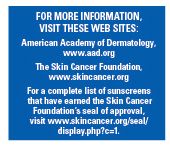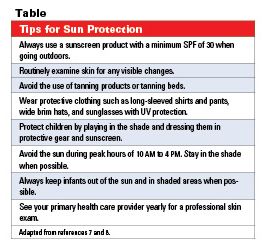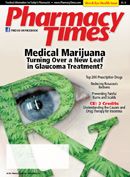Publication
Article
Pharmacy Times
Damage Control: Protecting Skin with Sun Care Products
Author(s):
An estimated 1 million cases of skin cancer are diagnosed each year in the United States. Pharmacists can help patients, especially those with risk factors, protect themselves from harmful UVA and UVB rays.

An estimated 1 million cases of skin cancer are diagnosed each year in the United States. Pharmacists can help patients, especially those with risk factors, protect themselves from harmful UVA and UVB rays.
Sunscreen products play a critical role in protecting the skin from both the short-term and long-term damaging effects of sun exposure.
There are 2 types of ultraviolet (UV) rays that can damage the skin: UVA and UVB. UVA is mainly responsible for wrinkling and premature aging of the skin. UVB rays are responsible for sunburn, tanning, and the acceleration of skin aging, and play a significant role in the development of skin cancer.1-5 The intensity of UVB rays varies by season, location, and time of day. In the United States, the most significant amount of UVB rays occur from 10 am to 4 pm between April and October.1-5
According to statistics from the Skin Cancer Foundation, an estimated 1 million cases of skin cancer are diagnosed annually in the United States.1,5 In addition, 90% of nonmelanoma skin cancers and up to 90% of the visible changes commonly attributed to aging of the skin are associated with exposure to UV radiation.6
Studies report that an individual’s risk of developing skin cancer doubles if he or she has had 5 or more episodes of sunburn.6 One or 2 cases of blistering sunburn during childhood may double an individual’s risk for developing melanoma later in life.1,4 Excessive or longterm exposure to UV radiation can also cause premature aging and wrinkling of the skin.1,7 Statistics show that 50% to 80% of all photodamage to the skin happens by at least 20 years of age.1
When applied correctly, sunscreen products can block most of the sun’s harmful UV rays.1 Sunscreen products are available in various formulations, including lotions, creams, and sprays; water-resistant formulations and various sun protection factor (SPF) ranges for both the pediatric and adult populations are also available. Sunscreens protect the skin by absorbing or reflecting UVA and UVB rays.8
The FDA requires that all sunscreens contain an SPF label.8 The higher the SPF, the greater protection provided. The Table shows how SPF ranges are classified in sunscreens.

Sunscreens that provide protection against both UVA and UVB are referred to as broad-spectrum sunscreens. The American Academy of Dermatology recommends the use of a broad-spectrum sunscreen with a minimum SPF of 30 even on cloudy days.7 Sun protection is equally important during the winter months, since snow reflects up to 80% of the sun’s rays and can cause sunburn and damage to exposed skin.2,7
Risk Factors
Some individuals are more susceptible to developing sunburn than others because of certain risk factors. These include1:
• Individuals with fair skin.
• Children with unprotected skin, because their skin is more sensitive than adults’ skin.
• Individuals taking certain pharmacologic agents.
• Individuals who use tanning beds.
• Individuals exposed to the sun during peak hours without UV protection.
Sunscreen Products
Selecting from the diverse variety of sunscreen products on the market may be overwhelming for some patients, so pharmacists should be prepared to assist them in selecting a sunscreen product that suits their individual needs.
Topical sunscreen products can be divided into 2 categories—chemical and physical. Chemical sunscreens work by absorbing, and therefore blocking, the transmission of UV rays to the epidermis, whereas physical sunscreens are typically opaque and work by reflecting and then scattering UV rays.1,7 Chemical sunscreens may contain amino benzoic acid and its derivatives, anthranilates, benzophenones, cinnamates, dibenzoylmethane derivatives, or salicylates.1,7
Physical sunscreens are often used on small areas, such as the nose or top of the ears, and contain zinc oxide or titanium.1,7 They are especially useful for those individuals allergic to the ingredients found in chemical sunscreens. 1,7
Many products on the market contain a combination of ingredients, including both chemical and physical sunscreens. Terephthalylidene dicamphor sulfonic acid (ecamsule) was approved by the FDA in 2006 and is classified as a waterresistant broad-spectrum sunscreen. It is often combined with octocrylene to increase its stability to light.1
There are several factors to consider when selecting a sunscreen product. Examples of these factors include cost, skin type and complexion, reasons for using sunscreen, ease of use, formulation, SPF, history of sunburn, and medication history, since some pharmacologic agents may be associated with photosensitivity reactions.
In order to achieve optimal photoprotection, it is crucial that patients understand how to properly apply sunscreen products. Sunscreens should be applied liberally to all exposed areas at least 15 to 30 minutes before sun exposure and as often as the product label recommends.1,8 In general, an estimated one-half teaspoonful should be applied thoroughly to each exposed area to obtain adequate coverage.1,8,9 Sunscreen should be applied every 2 hours and after swimming, towel drying, or excessive sweating.7
According to the FDA, sunscreens labeled “water-resistant” must maintain their SPF after 40 minutes of water immersion, while those labeled “very water-resistant” must maintain their SPF after 80 minutes of water immersion.1,9 If an individual works outdoors, sunscreen should be reapplied often throughout the day.1,9-11
Conclusion
Pharmacists are in a unique position to provide patients with pertinent information to enable them to make informed decisions about the various products available for proper photoprotection.
Pharmacists should remind those patients at risk for photosensitivity reactions due to the use of certain pharmacologic agents (eg, tetracyclines, antidepressants, antihistamines, estrogens, sulfonamides, nonsteroidal anti-inflammatory drugs) to always use sunscreen when outdoors. During counseling, it is imperative to remind these patients about the importance of UV protection.
Increasing overall patient awareness about the significance of routine UV ray protection can avoid or decrease the incidence of sunburn, promote the overall integrity and health of patients’ skin, and potentially decrease their chances of developing skin cancer. %u25A0



Ms. Terrie is a clinical pharmacy writer based in Haymarket, Virginia.
References
1. Crosby K. Prevention of Sun-induced Skin Disorders. In: Berardi R, Newton G, McDermott JH, et al, eds. Handbook of Nonprescription Drugs. 16th ed. Washington, DC: American Pharmacists Association; 2009:729-733.
2. The Sun and Your Skin. American Academy of Dermatology Web site. http://www.aad.org/public/publications/pamphlets/sun_sun.html www.aad.org/public/Publications/pamphlets/SunandSkin. Accessed February 25, 2010.
3. Sun Exposure. Medline Plus Web site. http://www.nlm.nih.gov/medlineplus/sunexposure.html. Accessed February 24, 2010.
4. Stoppler M. Making Sense of Sunscreens. Medicine.Net Web site http://www.medicinenet.com/script/main/art.asp?articlekey=46376. Accessed February 24, 2010.
5. Shining Light on Ultraviolet Radiation. Skin Cancer Foundation Web site. http://www.skincancer.org/UV-Information/shining-light-on-ultraviolet-radiation.htmlAccessed February 26, 2010.
6. Skin Cancer Facts. Skin Cancer Foundation Web site. http://www.skincancer.org/Skin-Cancer-Facts/.Accessed February 26, 2010.
7. Sunscreens/sunblocks. The American Academy of Dermatology Web site. http://www.aad.org/public/publications/pamphlets/sun_sunscreens.html. Accessed February 26, 2010.
8. Facts about sunscreens. The American Academy of Dermatology Web site. http://www.aad.org/media/background/factsheets/fact_sunscreen.htm. Accessed February 24, 2010.
9. Sunscreen: The Burning Facts. The United States Environmental Protection Agency Web site. http://www.epa.gov/sunwise/doc/sunscreen.pdf. Accessed February 26, 2010.
10. Sunscreen: How to Select, Apply, and Use It Correctly. http://www.cdc.gov/MMWR/preview/mmwrhtml/rr5104a3.htm. Accessed February 26, 2010.
11. Prevention Tips. Skin Cancer Foundation Web site. http://www.skincancer.org/prevention/scf-tips.html.Accessed February 25, 2010.








